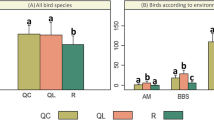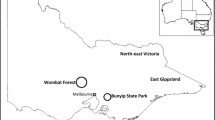Abstract
Fire is a crucial element needed to understand the biodiversity patterns of forest landscapes in most Mediterranean countries. However, little is known about the quantitative responses of bird communities to postfire forest management in this region, in which the logging of burnt trees is a common practice. Several studies have already described the negative effects of felling burnt trees on birds but none has focussed on the remaining wood remnants. We investigated this question in a large burnt area located in north-east Iberian Peninsula. The amount of logging remnants left on the ground had positive linear and negative quadratic relationships with the indices of bird abundance and bird richness. The results obtained at a species level were similar, since 36% of the most abundant species revealed the same type of relations with logging remnants, whereas none showed an opposite pattern. Thus, birds in general seem to be positively influenced by the amount of wood remnants left on the ground to a certain point, from which the relation reverses. The results of this study indicate that a moderate amount of wood remnants left on the ground may be positive for the overall bird community. We suggest that management plays a role in the recovery of the bird community after fire and, therefore, biodiversity criteria should be incorporated in the guidelines driving postfire actions.



Similar content being viewed by others
References
Apfelbaum S, Haney A (1981) Bird populations before and after wildfire in a Great Lakes pine forest. Condor 83:347–354. doi:10.2307/1367504
Beschta RL, Frissell CA, Gresswell R, Hauer R, Karr JR, Minshall GW, Perry DA, Rhodes JJ (1995) Wildfire and salvage logging. Recommendations for ecologically sound postfire salvage management and other postfire treatments on federal lands in the west. Oregon State University, Corvallis
Beschta RL, Rhodes JJ, Kauffman JB, Gresswell RE, Minshall GW, Karr JR, Perry DA, Hauer FR, Frissell CA (2004) Postfire management on forested public lands of the western United States. Conserv Biol 18(4):957–967. doi:10.1111/j.1523-1739.2004.00495.x
Bibby CJ, Burgess ND, Hill DA, Mustoe SH (2000) Bird census techniques, 2nd edn. Academic Press, London
Brotons L, Herrando S, Martin JL (2004) Bird assemblages in forest fragments within Mediterranean mosaics created by wild fires. Landsc Ecol 19:663–675. doi:10.1007/s10980-005-0165-2
Brotons L, Pons P, Herrando S (2005) Colonisation of dynamic Mediterranean landscapes: where do birds come from after fire? J Biogeogr 32:789–798. doi:10.1111/j.1365-2699.2004.01195.x
Dixon RD, Saab VA (2000) Black-backed Woodpecker (Picoides arcticus). In: Poole A, Gill F (eds) The birds of North America, vol 509. The Birds of North America, Inc, Philadelphia
Donato D, Fontaine J, Campbell J, Robinson D, Kauffman B, Law B (2006) Postwildfire logging hinders regeneration and increases fire risk. Science 311(5759):352. doi:10.1126/science.1122855
Estrada J, Pedrocchi V, Brotons L, Herrando S (eds) (2004) Catalan Breeding Bird Atlas 1999–2002. Catalan Ornithological Institute/Lynx editions, Barcelona
Gaston KJ, Blackburn TM (2000) Pattern and process in macroecology. Blackwell Science, Oxford
Haim A, Izhaki I (2000) The effect of fire treatments on the community composition of small mammals in a postfire pine forest. J Mediterr Ecol 1:249–257
Haim A, Rozenfeld A, Izhaki I (1997) Post-fire response of shrews (Crocidura suaveolens) on Mount Carmel, Israel. Mammalia 61(4):527–536
Herrando S, del Amo R, Brotons L, Llacuna S (2001) Factors influencing postfire dynamics of Sardinian and Dartford warblers in Mediterranean shrublands. Ornis Fenn 78:168–174
Herrando S, del Amo R, Brotons L, Llacuna S (2002) Bird community succession after fire in a dry Mediterranean shrubland. Ardea 90:303–310
Hitchcox SM (1996) Abundance and nesting success of cavity-nesting birds in unlogged and salvage-logged burned forests in northwestern Montana. MSc thesis, Univesity of Montana
Hutto RL (1995) Composition of bird communities following stand-replacement fires in northern Rocky Mountain (USA) conifer forests. Conserv Biol 9:1041–1058. doi:10.1046/j.1523-1739.1995.9051041.x
Hutto RL (2006) Toward meaningful snag-management guidelines for postfire salvage logging in North American conifer forests. Conserv Biol 20(4):984–993
ICO (2007) Programa SOCC. Cinquè informe del Seguiment d’Ocells Comuns a Catalunya. ICO, Barcelona http://www.ornitologia.org/monitoratge/reportsocc5.pdf
Imbeau L, Savard JPL, Gagnon R (1999) Comparing bird assemblages in successional black spruce stands originating from fire and logging. Can J Zool 77(12):1850–1860. doi:10.1139/cjz-77-12-1850
Izhaki I (1996) The resilience to fire of passerine birds in an east Mediterranean pine forest on Mount Carmel, Israel: the effects of postfire management. In: Trabaud L, Prodon R (eds) Fire in Mediterranean ecosystems. Ecosystems research report 5. Commission of the European Communities, Brussels
Izhaki I, Adar M (1997) The effects of postfire management on bird community succession. Int J Wildland Fire 7:335–342. doi:10.1071/WF9970335
Jones RH, Stokes SL, Lockaby BG, Stanturf JA (2000) Vegetation responses to helicopter and ground based logging in blackwater floodplains forests. For Ecol Manag 139:215–225. doi:10.1016/S0378-1127(00)00269-3
Kreisel KJ, Stein SJ (1999) Bird use of burned and unburned coniferous forest during winter. Wilson Bull 111(2):243–250
Leonard DL (2001) Three-toed Woodpecker (Picoides tridactylus). In: Poole A, Gill F (eds) The birds of North America, vol 588. The Birds of North America, Inc, Philadelphia
Lindenmayer DB, Ough K (2006) Salvage logging in the montane ash eucalypt forests of the central highlands of Victoria and its potential impacts on biodiversity. Conserv Biol 20(4):1005–1015
Lindenmayer DB, Foster DR, Franklin JF, Hunter ML, Noss RF, Schmiegelow FA, Perry D (2004) Salvage Harvesting Policies After Natural Disturbance. Science 303(5662):1303. doi:10.1126/science.1093438
Llimona F, Matheu E, Prodon R (1993) Role of snag persistence and of tree regeneration in postfire bird successions: comparison of pine and oak forests in Montserrat (Catalonia, NE Spain). In: Trabaud L, Prodon R (eds) Fire in Mediterranean ecosystems. Ecosystems research report 5. Commission of the European Communities, Brussels
Marqués MA, Mora E (1998) Effects on erosion of two postfire management practices: clear-cutting versus non-intervention. Soil Tillage Res 45:433–439. doi:10.1016/S0933-3630(97)00039-1
McCullagh P, Nelder J (1989) Generalised linear models, 2nd edn. Chapman & Hall, London
McIver JD, Starr L (eds) (2000) Environmental effects of postfire logging: literature review and annotated bibliography. USDA Forest Service, Pacific Northwest Research Station Report PNW-GTR-486, Portland
Moreira F, Ferreira PG, Rego FC, Bunting S (2001) Landscape changes and breeding bird assemblages in northwestern Portugal: the role of fire. Landsc Ecol 16:175–187. doi:10.1023/A:1011169614489
Morelan LZ, Mealey SP, Carroll FO (1994) Forest health on the Boise National Forest. J For 92(8):22–24
Murphy EC, Lehnhausen WA (1998) Density and foraging ecology of woodpeckers following a stand-replacement fire. J Wildl Manag 62:1359–1372. doi:10.2307/3802002
Nappi A, Drapeau P, Giroux JF, Savard JP (2003) Snag use by foraging Black-backed woodpeckers (Picoides arcticus) in a recently burned eastern boreal forest. Auk 120(2):505–511. doi:10.1642/0004-8038(2003)120[0505:SUBFBW]2.0.CO;2
Pons P, Prodon R (1996) Short term temporal patterns in a Mediterranean shrubland bird community after fire. Acta Oecol 17(1):29–41
Prodon R, Lebreton JD (1981) Breeding avifauna of a Mediterranean succession: the Holm Oak and the Cork Oak series in eastern Pyrenees. Oikos 37:21–38. doi:10.2307/3544069
Prodon R, Fons R, Athias-Binche F (1987) The impact of fire on animal communities in the Mediterranean area. In: Trabaud L (ed) The role of fire on ecological systems. SPB Academic Publishing, The Hague
Raftoyannis Y, Spanos I (2005) Evaluation of log and branch barriers as postfire rehabilitation treatments in a Mediterranean pine forest in Greece. Int J Wildland Fire 14(2):183–188. doi:10.1071/WF04031
Robichaud PR, Beyers JL, Neary DG (2000) Evaluating the effectiveness of postfire rehabilitation treatments. USDA Forest Service, Rocky Mountain research station paper RMRS-GTR-63, Fort Collins
Sessions J, Bettinger P, Buckman R, Newton M, Hamann J (2004) Hastening the return of complex forests following fire: The consequences of delay. J For 102(3):38–45
StatSoftInc (2004) Statistica (data analysis software system), version 7. http://www.statsoft.com. Cited 10 May 2007
Tsitsoni TK, Tsakaldimi MN, Ganatsas PP, Zagas TD (2004) Effect of postfire treatments on the natural regeneration of Pinus brutia in northern Greece. In: Arianoutsou M, Papanastasis VP (eds) Proceedings of 10th MEDECOS conference, April 25–1 May, 2004, Rhodos Greece. Millpress, Rotterdam
Wiens JA (1989) The ecology of bird communities, vol I–II. Cambridge University Press, Cambridge
Acknowledgments
This study has been funded by the Department of Natural Parks of Diputació de Barcelona. This work is has been also supported by the project CGL2005-2000031/BOS granted by the Spanish Ministry of Education and Science. S.H. belongs to the Grup de Recerca Consolidat 2005SGR00602. L.B. benefited from a Ramon y Cajal contract from the Spanish government. We especially wish to acknowledge the great support from Daniel Guinart, biologist at the Sant Llorenç del Munt Natural Park. We also wish to thank Javier Quesada, Joan Estrada, Oriol Baltà, Raül Aymí and four anonymous referees for their constructive comments on previous drafts of the manuscript.
Author information
Authors and Affiliations
Corresponding author
Rights and permissions
About this article
Cite this article
Herrando, S., Brotons, L., Guallar, S. et al. Postfire forest management and Mediterranean birds: the importance of the logging remnants. Biodivers Conserv 18, 2153–2164 (2009). https://doi.org/10.1007/s10531-009-9579-5
Received:
Accepted:
Published:
Issue Date:
DOI: https://doi.org/10.1007/s10531-009-9579-5




